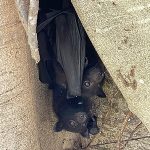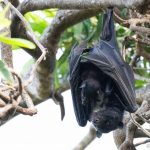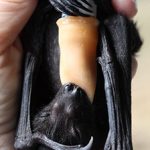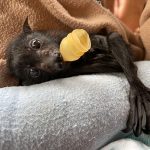BLACK FLYING-FOX
The Black Flying-fox: Australia’s Night-time Gardener
Step into a warm, moonlit evening along a northern river and you may hear it first: a soft, leathery flutter above the canopy. A dark shape crosses the stars, the scent of eucalypt blossom hangs in the air, and a black flying-fox glides with steady, purposeful wings. These remarkable bats stitch together Australia’s forests each night—moving pollen, spreading seeds, and keeping native woodlands alive.
Quick Facts
| Feature | Details |
|---|---|
| Scientific name | Pteropus alecto |
| Also known as | Black fruit-bat |
| Wingspan | Up to about 1.2 metres |
| Weight | Roughly 600–1,000 grams |
| Lifespan | Typically 8–15 years in the wild; over 20 years in care |
| Diet | Nectar, pollen, and fruit (especially eucalypts, melaleucas, banksias, and native figs) |
| Range | Northern and eastern Australia (Kimberley across the Top End and down the Queensland coast into northern NSW), plus New Guinea |
| Roosts | Large daytime camps in trees near water—mangroves, paperbarks, river flats, and sometimes urban parks |
| Conservation status | IUCN: Least Concern; not nationally listed as threatened in Australia (status may vary by state/territory) |
How to Recognise Them
- Mostly black fur with a sometimes rusty-brown collar around the neck.
- A dog-like face with large eyes and long, narrow ears.
- Often seen in big evening streams heading out to feed, and returning before sunrise.
Life, Diet and Role in the Ecosystem
Black flying-foxes are long-distance pollinators and seed dispersers. They travel tens of kilometres in a single night, following flowering pulses of eucalypts, melaleucas and banksias, and the fruiting of native figs. As they feed, pollen dusts their faces and fur, and seeds are carried across the landscape—work that keeps forests connected, resilient and diverse.
- Breeding: Usually one pup per year, born spring to early summer (varies with region and climate). Mothers carry their young for weeks and continue to nurse for months.
- Social life: They roost together in camps that can number from a few hundred to many thousands. These camps shift in response to food and weather, acting like living maps of seasonal abundance.
Longevity
- In the wild: commonly around 8–15 years.
- In care: individuals can surpass 20 years. Their long life and low birth rate mean populations recover slowly from major losses.
Conservation Status
- IUCN Red List: Least Concern (due to wide range and large overall population).
- Australia: Not listed as threatened nationally under the EPBC Act.
- States and Territories: Generally not listed as threatened (check local listings, as management approaches differ). Even with a “Least Concern” label, local populations can face serious pressure from habitat loss, extreme heat, and conflict in urban and agricultural settings.
Key Threats
- Habitat loss and fragmentation: Clearing of flowering and fruiting trees reduces food and roost sites.
- Extreme heat events: Prolonged temperatures above about 42°C can cause mass heat-stress deaths, especially affecting young.
- Harmful netting and barbed wire: Entanglement in loose, wide-mesh fruit netting and barbed wire near food trees and water points.
- Powerlines and urban hazards: Electrocutions and collisions.
- Disturbance at camps: Particularly harmful during maternity season.
- Food shortages: When flowering fails, starvation events can occur.
- Misunderstanding and conflict: Stigma and persecution despite low risk to people who do not handle bats.
What You Can Do to Help
1) Make Backyards and Farms Wildlife-Safe
- Use wildlife-safe fruit netting: Choose tightly knitted netting with mesh small enough that you cannot poke your finger through. Stretch it taut over a solid frame so bats cannot become entangled. Avoid thin, monofilament nets.
- Replace or modify barbed wire: Remove barbed strands near fruiting trees and water, or cover the top wire with split poly pipe or similar guards so bats do not snag during low flights.
- Plant for year-round food: Choose nectar- and fruit-rich native trees to provide staggered flowering and fruiting.
- Examples: Eucalyptus robusta (Swamp Mahogany), Corymbia tessellaris, Melaleuca quinquenervia (Paperbark), Lophostemon confertus (Brush Box), native figs like Ficus virens and F. macrophylla, and Syzygium (Lilly Pillies).
- Keep pets indoors at night when trees are fruiting to reduce conflict and injuries.
2) Protect and Restore Habitat
- Support the protection of roost trees and buffers around camps, especially near rivers, lakes and mangroves.
- Join or support local Landcare, Bushcare or revegetation groups planting native canopy species.
- Advocate for urban planning that retains mature flowering trees and safeguards known roost sites.
3) Encourage Responsible Orchard Management
- Promote full-coverage, wildlife-safe netting over orchards rather than lethal controls.
- Use deterrents that do not harm wildlife and maintain compliance with state regulations.
4) Respond Safely to Injured or Heat-Stressed Bats
- Do not handle bats. For your safety and theirs, only vaccinated, trained carers should handle them (due to Australian bat lyssavirus risk).
- If you find an injured bat or see heat stress (bats on lower branches, panting, spreading wings), contact your local wildlife rescue:
- All states: WIRES national helpline
- NSW: WIRES
- QLD: Bat Conservation & Rescue
- NT: Wildcare
- WA (Kimberley): Local wildlife rescue groups
- Provide the location and description; follow guidance from rescuers. Do not attempt to give water directly.
5) Be a Voice for Flying-foxes
- Share evidence-based information about their ecological value.
- Support research and citizen science projects tracking flowering, fruiting and camp movements.
- Encourage heatwave preparedness plans for known camps (managed by councils and expert teams).
A Night in the Canopy
On a still, warm night the trees hum with insect song. A black flying-fox lands high in a paperbark, the leaves whispering against its folded wings. Its fur smells faintly of blossom. It feeds and moves on, carrying pollen to the next tree, and the next—stitching together a living fabric over kilometres of forest. By dawn, that work will be invisible to most of us, but the forests will breathe easier for it.
Why Their Future Matters
Black flying-foxes are an essential link between patches of habitat—particularly important as climate change reshapes flowering seasons. By safeguarding roosts, planting native trees, and using wildlife-safe practices at home and on farms, we protect not only a species, but the health of entire ecosystems that support birds, mammals, and people alike.
If we listen for those soft wingbeats at dusk and act with care, the night-time gardeners will keep our forests thriving for generations to come.








